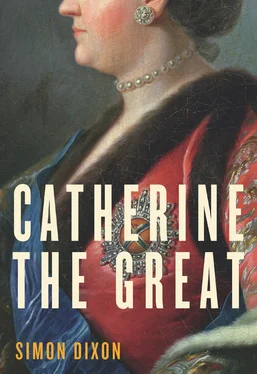Here, it seemed, was a classic case in which the need for a ritual celebration of the crown’s legitimacy had increased as the stability of the state became less certain. 43Yet Catherine was undoubtedly playing for high stakes in holding the coronation so soon after her coup. Some of her most influential supporters, headed by Paul’s tutor, Count Nikita Panin, had expected her to rule as regent for her son, and no Russian regent had yet been crowned. 44The precedents could scarcely have been less encouraging. Tsarevna Sophia, who governed Muscovy on behalf of the boy tsars Ivan V and Peter I from 1682 to 1689, had fatally undermined her authority by campaigning for recognition as ruler in her own right. In The Antidote (1770), a polemical work intended to convince sceptical Europeans of Muscovite achievements, Catherine later claimed that Sophia had ‘not been given the credit she deserves’: ‘She conducted the affairs of the Empire for a number of years with all the sagacity that one could hope for.’ But the empress can hardly have relished the prospect of ending her life under house-arrest in a convent, the fate that befell Sophia following the coup that installed Peter the Great as de facto sole ruler. 45In principle, there was no need to hurry: nowhere in Europe was the interval between accession and coronation prescribed, and Louis XIV, given pause by noble unrest during the Fronde, had set a French record by waiting eleven years before staging his in 1654. 46Yet the fate of Peter III warned Catherine against delay. By putting off his coronation on the grounds that the regalia were not yet ready, her husband had merely advertised the contempt for Orthodox tradition that contributed to his downfall. Determined to learn from his mistakes, Catherine, as a hostile French diplomat reported in early October, missed ‘no opportunity to convey to her people a great idea of her profound piety and devotion to the Greek religion’. 47
The vision of Peter III’s strangled corpse was not the only violent image that might have flashed across the empress’s mind as she descended a flight of stairs that had borne silent witness to some of the bloodiest scenes in Russian history. A reference in her memoirs to the ‘famous’ Red Staircase suggests that tales of the Moscow rebellion that brought Sophia to power in May 1682 might have been part of the folklore she learned from her pious lady-in-waiting, Praskovya Vladislavova (‘that woman was a living archive who knew the scandalous history of every family in Russia from the time of Peter the Great and beyond’). 48It was then that the boyar Artamon Matveyev, once the leading minister to Tsar Aleksey Mikhailovich (1645–76), had allegedly been hurled from the top of the stairs onto the pikes of the mutinous musketeers. Reformed into new regiments by Peter the Great, the Guards had been guarantors of the Russian throne ever since. Conscious that resentment of her relationship with Orlov extended even to supporters of her own coup, Catherine knew as she gazed down on the serried ranks of extravagantly plumed helmets that it would take only one treacherous officer to ignite a riot. The threat was real enough: not long after the coronation, some fifteen guardsmen were arrested and tortured on suspicion of a conspiracy to dethrone her in favour of Ivan VI. 49On the morning of 22 September, however, all remained tranquil as the crowd waited patiently in silence—a sign not of popular disapproval, as it would have been in France, but rather of awed anticipation, as the official record of the coronation was anxious to stress. 50
* * *
Seeking to invent a myth of legitimacy for the new empress, Catherine’s supporters set out to demonstrate the parallels between her and Elizabeth, and beyond Elizabeth to her father, Peter the Great. ‘Elizabeth has risen for our sakes,’ proclaimed Mikhailo Lomonosov in his ‘Ode on the Accession of Catherine II’: ‘Catherine is the unity of both!’ 51To drive home the analogy, artists painted Catherine in poses already familiar from portraits of Elizabeth. To ensure that the new empress’s coronation followed the same format as Elizabeth’s twenty years earlier, Trubetskoy refreshed his memory of that event by researching the historical precedents. 52Even as Catherine’s procession made its stately progress towards the Cathedral of the Dormition, her leading supporters offered a visible representation of continuity among Russia’s governing elite.
Although that elite served the tsar in a variety of military and bureaucratic organisations, their institutional hierarchies were then overlaid (as they have been ever since in Russia) by a network of informal patronage groups too flexible to be classed as factions. By marrying into the Romanov dynasty, the Saltykovs and the Naryshkins, themselves related by marriage to the Trubetskoys, had cornered an increasing number of leading offices since the reign of Peter the Great. 53So it is no surprise to find Peter Naryshkin among the gentlemen-in-waiting carrying the empress’s train and Lev Naryshkin among her closest friends. The imperial mantle was entrusted to Field Marshal Peter Saltykov, a hero of the Seven Years’ War whom Catherine admired as ‘a very good man, active and full of good sense’. 54She made him Governor General of Moscow. The state sword, first used in 1742, was carried by the Master of the Horse, Peter Sumarokov, whose service in the Senate stretched back to Anna’s reign in the 1730s. Admiral Ivan Talyzin, who had ridden out into Cathedral Square to shower coins over the populace at Elizabeth’s coronation, now carried the state seal. 55During Catherine’s coup at the end of June, he had been responsible for turning away the deposed Peter III from the island fortress of Kronstadt. The crown itself was borne by Aleksey Razumovsky, a Ukrainian of Cossack extraction whom Elizabeth had promoted as her Grand Master of the Hunt after plucking him from the choir loft to become her lover thirty years earlier. In his case, lineage was less important than loyalty, and no one was more loyal to Catherine than Count Aleksey Petrovich Bestuzhev-Ryumin. Having initially opposed her invitation to Russia in 1744, Bestuzhev had been arrested fourteen years later as one of her most faithful supporters. Now, ‘debauched, profligate, deceitful and interested to excess’, 56the old man was about to enjoy a brief Indian summer.
Waiting to greet her at the south portal of the cathedral, Archbishop Dimitry imparted a vital sense of authority to the whole proceedings. At the beginning of the nineteenth century, the story circulated that he made Catherine tremble by inquiring severely, ‘Why have you come?’ 57In reality, however, there could hardly have been a more reassuring figure for the empress to meet at the start of a ritual intended to symbolise the harmony of the earthly and the celestial spheres—he had been rewarded for his support during her coup with the personal grant of 1000 serfs. 58Surrounded by no fewer than twenty bishops, thirty-five archimandrites and a host of lesser clergy resplendent in their finest vestments, Catherine kissed the life-giving cross, believed to be studded with a fragment from Christ’s crucifix, and followed Dimitry and Metropolitan Timofey past the massive, copper-plated doors into an aesthetic world that, for all her professions of loyalty to the Orthodox faith, she never fully understood.
Already installed on tiered benches erected between the cathedral’s four great internal pillars was a select congregation of Court ladies, native dignitaries and foreign diplomats who had not taken part in the procession and had, as usual, been left uncertain about the arrangements until the last moment. Like the others, the French ambassador received his invitation only on 20 September, after frantic negotiations about precedence in the seating plan: ‘There was nothing they could have done to persuade me to appear at the coronation as a gawping tourist.’ 59Facing the altar, in a gallery in front of the west wall, the diplomats occupied the first row with the Baltic nobility behind them, brigadiers in the third row and the Baltic merchants at the back. Female guests sat along the north wall, ranged according to rank behind Countess Anna Vorontsova, and the empress’s ladies and maids of honour. Opposite them was a gallery for the foremost Russian officials. Holders of the first three ranks on the Table decreed by Peter the Great in 1722 sat at the front with lesser-ranking bureaucrats further back. 60
Читать дальше












